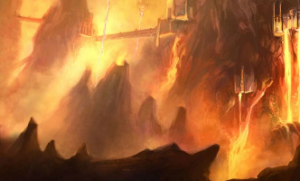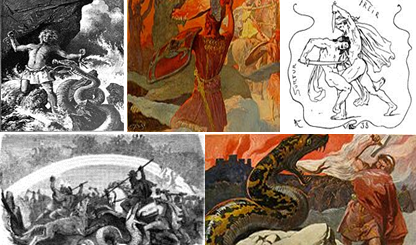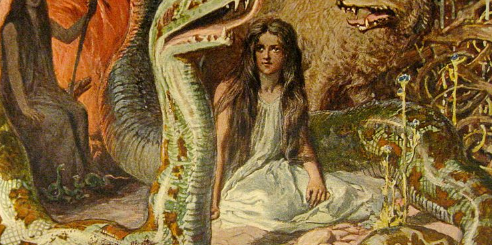The Nine Realms in Norse Cosmology

The Nine Realms in the Norse cosmos are: Asgard (Realm of the Aesir), Vanaheim (Realm of the Vanir gods), Nidavellir (Realm of dwarfs), Jotunheim (Realm of the giants), Alfheim (Realm of the Bright Elves), Niflheim (Realm of Ice), Muspelheim (Realm of fire), Midgard (Realm of humans), and Svartalfheim (Realm of the Black Elves).
Like any polytheistic culture, ancient Scandinavian tribes and Nordic tribes believed in the partition of the cosmos into realms for different beings. In Norse mythology, it was believed that the cosmos was divided into the realm for mortals, which was known as Midgard, and the realm for the Norse gods, which was known as Asgard. Those two realms often make up the most discussed worlds in Norse mythology. However, those weren’t the only realms in Norse mythology – there are Nine Realms actually. Those nine worlds hanged in a delicate balance on a universal tree known as the Tree of Life (i.e. Yggdrasil).
In the article below, we take an in-depth look at the Nine Realms in Norse mythology.
Asgard

Asgard, also known as “enclosure of the Aesir”, is the home of the Aesir, principal gods in Norse mythology
Attested to in the myths as the realm of the divine gods, Asgard is a magnificent place known for its splendid castles and beautiful scenery. This realm is home to the Aesir gods, one of the two major races of gods in Norse mythology.
The Aesir, who were the main deities in the cosmos, were known for their insatiable thirst for knowledge, conquests and warrior lifestyle. Leading this realm is the All-father god Odin, Norse god of war, knowledge, magic, and a host of other things. Examples of famous Aesir gods that call Asgard their home are Odin’s children, which includes Thor, Baldur, and Vidar; Tyr, god of war; Heimdallr, the watchman of Asgard; Frigg, the queen of Asgard; and Vali and Ve, and many others.
Asgard is also home to Loki, the Norse shape-shifting god of mischief. Technically not an Aesir, Loki is described in the myths as the adopted brother of Odin. He was welcomed into Asgard with open arms; however, the trickster ends up being a pain in the neck of many Aesir gods. Loki and his three monstrous children (Jormungandr, Hel and Fenrir) are directly responsible for Ragnarok.
Asgard contains some very important places in Norse mythology. For example, Valhalla – Odin’s Great Hall for brave and worthy warriors – stands magnificently in Asgard. This realm of the Aesir gods is also home to three important wells that nourish the roots of Yggdrasil.
Just beneath Asgard are three other realms – Midgard, Alfheim and Muspelheim – which we shall explore below.
The Bifrost Bridge is the famous magical gateway that connects Asgard to Midgard (the realm of mortals and humans). It’s said that the Norse god Heimdall guards the Bifrost, ensuring that Asgard is kept safe from uninvited guests and intruders. The realm Asgard is also surrounded by a mighty wall to keep the Aesir gods safe from the troublesome giants (jotnar).
Come Ragnarok, the realm of the Aesir gods, like the other eight realms, will be destroyed by evil forces primarily led by Loki and his three monstrous children.
Read More: Top 10 Powerful Gods and Goddesses in Norse Mythology
Midgard

Midgard is one of the realms the lie beneath Asgard (the realm of the Aesir gods). Ask and Embla are seen as the progenitors of humans in the realm of Midgard (Earth).
In the myths, Midgard, the realm of humans and mortals, came to being after Odin and his two brothers Veli and Vé killed the frost giant Ymir. Odin and his siblings are believed to have used the eyebrows and eyelashes of Ymir to create the fence of Midgard. Shortly after the creation of the world, Odin and his brothers fashioned out the first man (Ask) and woman (Embla) from two elm tree trunks that had drifted onto a the seaside. Vili was responsible for giving the first two humans the breath of life, while Vé gifted the humans their five senses – i.e. the ability to speak, hear, think, feel, and see. Those two first humans then went on to populate the world.
As stated above, the realm of Midgard is connected to Asgard by the Bifrost Bridge. On many occasions the Aesir gods have travelled via the Biafrost into Midgard.
Midgard, like the eight other worlds, is fated to be destroyed during Ragnarok, when the forces of evil and chaos will fight against the Norse gods. For example, both Fenrir and Jormungandr will go on a rampage through Midgard and leave destruction and misery in their wake. Mountains will split up and break, and seas will boil, while the earth’s atmosphere will be filled with toxic gasses.
Alfheim

Alfheim was the of home of the light elves in Norse mythology. The realm abounds with beautiful elf creatures with glowing hue that are as bright as the sun.
Occupying the middle section of the Tree of Life, Alfheim is known in Norse mythology as the home of the light elves, beautiful creatures with glowing hue that are as bright as the sun. As a result, the elves are considered the fairest of beings in the Nose cosmos. The elves are also treated as muses as they are known for inspiring art and culture throughout the cosmos. Like the light elves, Alfheim is famous for its tranquil and serene environment.
Vanaheim

Vanaheim is the dwelling place of the Vanir, the less popular race of Norse gods. This realm is known for its rivers and very calm atmosphere. This is because the Vanir gods and goddesses live in peace among themselves. The Vanir deities are described as very wise and gifted in art of magic. They are also known for being fertility deities. Notable members of the Vanir are the sea god Njordr and his children, twin deities Freyja and Freyr. Deities like Hnoss, Gullveig, and Gersemi also call Vanaheim their home.
As a result of the Aesir’s jealousy over the sacrifices that Vanir deities received from humans, a war broke out between the Aesir and the Vanir. In a different version, the two races of gods locked horns because the Aesir did not approve of some of the social practices of the Vanir, including the use of magic.
In any case, the war reached a stalemate and the two sides had a peace agreement. As part of the truce, hostages were exchanged – The Aesir allowed Hoenir and Mimir to go and live among the Vanir gods, while the Vanir allowed Njord and his children – Freya and Freyr – to live among the Aesir.
While living in Asgard, Vanir goddess Freyja (or Freya) – goddess magic, fertility and beauty – famously showed the Aesir gods how to use magic.
Read More: List of Vanir Deities and their Origin Stories
Muspelheim

A primordial world of fire, Muspelheim is the home of the fire giants
Long before there was Midgard and other realms, there was Muspelheim, a primordial world of fire. This realm is regarded as the oldest of the realms, along with the cold and frigid realm of Nilfheim.
In the myths, Muspelheim is the home of the first fire giants, chief among them is the giant Sutr (Surt) who was known as “the swarthy one”. According to the poems in the Prose Edda and the Poetic Edda, Sutr will lead his fellow giants (the sons of Muspell) to do battle against the Aesir gods during Ragnarok. He will produce a terrible flame that will engulf large parts of Midgard. In the end, Sutr, with his fiery sword, will kill Norse god Freyr.
The name Muspelheim has been theorized to translate as “wreck of the world” in Old Norse.
Helheim

Helheim is the home of dead people who went selected by Odin’s warrior maidens (the Valkyries). It’s ruler is the giantess Hel, daughter of Loki
In simple terms, Helheim is the realm of the dead, and it is ruled by Hel, Queen of the dead. Hel is the daughter of Loki, Norse trickster deity. She is also sister to powerful monsters such as the Midgard Serpent Jormungandr and the mighty wolf Fenrir. Helheim was bestowed upon Hel by Odin. This was due to her deformed body – half of Hel’s body is a rotten corpse while the other half is as beautiful as the most beautiful woman in any of the realm.
Helheim is located buried beneath the roots of the Tree of Life. Thus it occupies the lowest part of the tree.
Although the Helheim is home to the dead, it only receives people who had an uninteresting life while alive. The slain brave warriors in battle do not go to Helheim. Those people make their way to Valhalla, where they dine and drink with the allfather Odin.
To get to Helheim, one has to take a path called Helveg and the make it past a bridge which leads to the gates of Helheim. Once a dead person enters Helheim, coming out is nearly impossible. This was seen in the case of the Norse god Baldr who was killed after Loki tricked the blind Norse god Hodr to shoot him with a mistletoe-fashioned arrow. Hel, the queen of the dead, on many occasions refused allowing Baldr leave Helheim. Odin himself took a journey down to Helheim in order to secure the release of his son Baldur. Hel then promised to let Baldur walk out of Helheim provided every dead and living object mourns his death. Being a beloved god, Baldur was mourned by everything and everyone in the cosmos, except Loki. As a result, Baldur could not secure his freedom out of Helheim.
However, come Ragnarok. Baldur will emerge from this realm and take his rightful place in the cosmos. The queen of the realm, Hel, will also fashion out a ship from the toenails and fingernails of the inhabitants of Helheim. She would then sail this ship out of Helheim in order to join her father and brothers in fighting against the Norse gods.
Did you know: The practice of burying a dead person with a sword or spear was used to convince the gods into believing that the dead person was a warrior in battle?
Niflheim

Niflheim – icy region and home of ice giants like Ymir
Popularly known as the birthplace of ice giants like Ymir, the Norse realm of Niflheim is described as an icy region. It ranks as oldest realm in Norse cosmology, along with Muspelheim. In Gylfaginning, the first part of Snorri Sturluson’s Prose Edda, an ancient king of Scandinavia discloses to Odin that Niflheim was the first realm to come into existence. It was then followed by the fiery realm Muspelheim.
The Gylfaginning also states that Ymir, the first giant in Norse mythology, was born from the coming together of the cold from Niflheim and the heat from Muspelheim.
Nilfheim is also home to a primordial well called Hvergelmir. This well is known for providing nourishment to the World Tree (Yggdrasil). Hvergelmir is also the source of all rivers in Norse cosmology.
Jotunheim

Jotunheim is the home of Norse giants (jotnar), arch enemies of the gods
The realm of the giants is known as Jotunheim in Norse mythology. Similar to Helheim, this realm is found beneath Asgard. Accessing the land of giants can be done by going across a frozen river called Iving. Due to rowdy nature of the giants, Jotunheim is described in the myths as a place that is rife with turmoil. Unlike the Aesir or Vanir gods who have rules and laws, the home of the giants lacks any form of laws, hence it has a very high level of chaos and needless destruction.
According to the myths, many of the Asgardian gods have journeyed to Jotunehim on fact-finding and military expeditions. One time, Odin sent a team of Aesir gods, led by Thor and Tyr, to bring into custody the three monstrous children of Loki. The children were taken away from their mother, the giantess Angrobdr.
In another myth, Loki helps Thor journey to Jotunheim in order to get back his hammer Mjolnir, which had been stolen by a giant.
Nidavellir or Svartalfheim

Black elves and dwarfs resided in the realm of black fields, also known as Nidavellir. The dwarfs were master artisans and smiths
This realm is the home of the Norse dwarfs. Located beneath Midgard, Nidavellir is also the home of the black elves. Both the dwarfs and black elves are famous for being master forgers and smiths. They use the precious stones and minerals buried beneath their land to forge the most magnificent objects in all of the Nine Realms. For example, the dwarfs are credited with forging powerful weapons of the Aesir gods, including Thor’s hammer Mjolnir, Odin’s spear Gungnir, Sif’s golden hair, the unbreakable chain Gleipnir, and Skíðblaðnir, among others.
It was in the realm of the dwarfs that Kvasir, the wisest among the Aesirs, was beheaded. The dwarfs the mixed honey with the blood of Kvasir to brew the Mead of Poetry. According to the myth, one sip of the mead made the drinker a very wise scholar and poet.
The dwarfs of Nidavellir were also known for keeping to themselves, preferring not to marry into another race, say the Aesir or Vanir.
More myths about the Nine Realms

The Ash Yggdrasil (1886) by German-born painter Friedrich Wilhelm Heine
- Come Ragnarok (the demise of the gods and the worlds), all the nine realms in the Norse cosmos will be destroyed by the forces of evil and chaos led by Loki and his jotunn (giant) race, which includes beings like Hel, the queen of the dead; Fenrir, the giant wolf; and Jormungandr, the Midgard serpent.
- According to the myths, Asgard sits firmly on top of Yggdrasil – the Tree of Life which holds all the Nine Realms together.
FACT CHECK: At world History Edu, we strive for the highest accuracy and objectivity. But if you come across something that doesn’t look right, please leave a comment below.



























